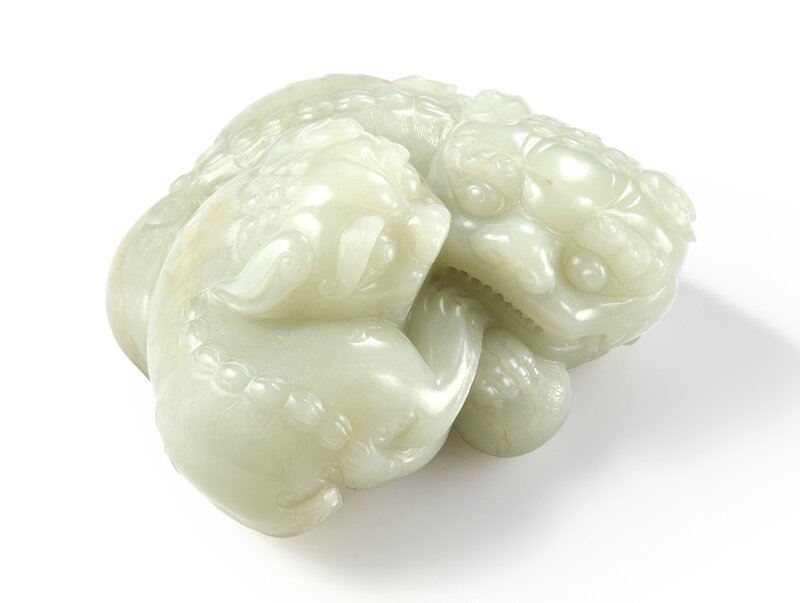A white jade 'Twin Buddhist lions' group, Qing dynasty, 18th century
LOt 75. A white jade 'Twin Buddhist lions' group, Qing dynasty, 18th century. Estimate 500,000 — 700,000 HKD. Photo: Sotheby's.
the substantial stone skilfully worked in the form of a pair of nuzzling Buddhist lions, each rendered with round bulging eyes below thick brows and mane defined in tight curls, its back with well-pronounced bosses along the spine terminating in a bushy tail, the smaller cub potrayed endearingly resting its front paws on the back of the elder lion, the latter with one paw on a brocade ball with a long ribbon depicted trailing along the underside, the stone of a pale celadon-tinged white colour with faint icy and grey inclusions, wood stand; 12.8 cm, 5 in.
Provenance: Christie’s London, 6th December 1993, lot 191
Notes: Fashioned from a particularly large white jade pebble, this charming carving is impressive for its sensitive and detailed modelling that pleasantly contrast the animals’ playful poses. The skill of the carver has been displayed to full effect in the naturalistically captured interlocking paws, and the meticulous carving of the creatures’ fur and notched spine. Jade animal sculptures such as this piece, generally depicted in reclining or seated poses, were kept in scholar’s studios where they probably served as decorative playthings or as paperweights. The large size and translucent stone of this piece would have made it a valued possession.
Jade sculptures of two reclining lions include ones sold in our New York rooms, 10th/11th April 1986, lot 236; another sold at Christie’s New York, 15th September 2011, lot 1008; a slightly smaller example from the Avery Brundage collection, in the Asian Art Museum of San Francisco, was included in the exhibition Chinese Jades from Han to Ch’ing, The Asia House Gallery, New York, 1980, cat. no. 54; and a fourth sold at Christie’s New York, 4th June 1987, lot 95. Compare also a jade carving of a lion and its cub, in the Palace Museum, Beijing, illustrated in Yang Boda, Chinese Jades Throughout the Ages, Hong Kong, 1997, pl. 54.
Sculptures of lions have a long history in Chinese history. Although known from as early as the Han dynasty, figures of lions in lapidary art developed with the spread of Buddhism, when they began to be placed at the entrance of temples and important halls to ensure the protection of those who entered. From the Tang dynasty onwards they were shown in pairs, the male with its paw over a sphere while the female with a cub, and only in the Ming and Qing dynasty depictions of playful lions began to acquire popularity.
Sotheby's. Roger Keverne - 50 Years in the Trade, Hong Kong, 05 oct. 2016, 10:00 AM

/https%3A%2F%2Fprofilepics.canalblog.com%2Fprofilepics%2F1%2F0%2F100183.jpg)
/https%3A%2F%2Fstorage.canalblog.com%2F03%2F02%2F119589%2F96711876_o.jpg)
/https%3A%2F%2Fstorage.canalblog.com%2F11%2F31%2F119589%2F94773502_o.jpg)
/https%3A%2F%2Fstorage.canalblog.com%2F20%2F83%2F119589%2F94772815_o.jpg)
/https%3A%2F%2Fstorage.canalblog.com%2F26%2F72%2F119589%2F75604929_o.jpg)
/https%3A%2F%2Fstorage.canalblog.com%2F59%2F60%2F119589%2F26458628_o.jpg)




/image%2F1371349%2F20240406%2Fob_a54acc_435229368-1644755382961141-18285727260.jpg)
/image%2F1371349%2F20240229%2Fob_b1ea4c_429582962-1625285201574826-43586635599.jpg)
/image%2F1371349%2F20240229%2Fob_84bc3b_429558450-1624783464958333-37673404077.jpg)
/http%3A%2F%2Fstorage.canalblog.com%2F36%2F88%2F119589%2F129555285_o.jpg)